Gersten J.I., Smith F.W. The Physics and Chemistry of Materials
Подождите немного. Документ загружается.

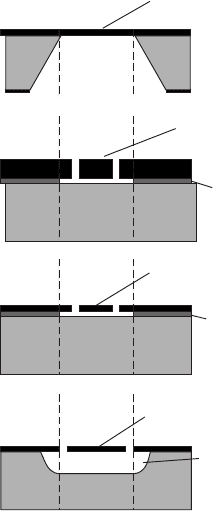
SYNTHESIS AND PROCESSING OF MATERIALS 373
Silicon nitride or
bulk silicon membrane
Anisotropic etching in KOH
Dry etching
(a)
(b)
(c)
(d)
Back etched bulk silicon
free standing (2 - 30 µm)
Silicon oxide (1 - 2 µm)
Free standing polysilicon
(0.5 - 2 µm)
Sacrificial layer (5 µm)
Surface micromachining
Free standing polysilicon
bulk silicon or silicon nitride
Etched porous
silicon 100 µm
Porous silicon technology
Figure W21.18. Micromachining processes currently used to fabricate microelectromechanical
systems (MEMS) from Si wafers: (a) anisotropic wet chemical etching; (b) dry etching or reac-
tive-ion etching; (c) surface micromachining involving a sacrificial layer of a-SiO
2
;(d) porous
Si technology, also involving surface micromachining but with much thicker sacrificial layers
of porous Si. [Reprinted from W. Lang, Mater. Sci. Eng., R17, 1 (1996). Copyright 1996, with
permission from Elsevier Science.]
Examples of these processes are shown in Fig. W21.18. Free-standing features (e.g.,
Si cantilevers) are readily produced. The key to the rapid growth of MEMS technology
is that most of these procedures involve deposition, lithography, and etching processes
that have already reached an advanced level of development in Si electronic device
fabrication. Porous Si, however, is a relatively new material consisting of variable
volume fractions of crystalline Si filaments or wires and of empty pores, which is
prepared by electrochemical anodic etching or anodization of crystalline Si in HF
(see Fig. W11.9). The use of thick porous Si in MEMS is also compatible with Si
device-fabrication techniques.
While Si electronic devices are essentially planar, containing circuit elements with
typical thicknesses ³ 1
µm, Si electromechanical devices or MEMS are truly three-
dimensional and often contain free-standing structures such as cantilevers and bridges.
The current trend in MEMS is to include several Si-based electronic devices and
mechanical sensors and actuators in a single MEMS. The most widely used Si
MEMS sensors at present are pressure transducers and thermopile radiation detectors.
Other MEMS include micromotors, micromirrors in optical switches, accelerometers,
microvalves, and flow sensors. In the future, MEMS actuators may be used to move
STM tips in three dimensions as part of data storage systems at the near-atomic level.

374 SYNTHESIS AND PROCESSING OF MATERIALS
Octahedral
sites
c
a
a
(a) (b)
100 µm
Figure W21.19. Martensite is a supersaturated solid solution of interstitial C in Fe.
(a) Body-centered tetragonal (BCT) unit cell of martensite. The Fe atoms are actually displaced
from their normal lattice sites to accommodate the C atoms in the octahedral sites. (b)Lath
microstructure of martensite in a Fe–2Mn–0.03C wt % steel. (From ASM Handbook, 9th ed.,
Vo l . 9 , Metallography and Microstructures, ASM International, Materials Park, Ohio, 1985,
p. 670.)
W21.10 Synthesis and Processing of Steels
While the simplest steels are just Fe–C alloys, steels in general can be very complex
materials in both composition and microstructure. This complexity makes the design
of a steel with a given set of properties quite challenging. It is useful first to review
how the complex phases that may be present in steels are related to the simpler phases
of pure Fe and Fe–C compounds and alloys.
Nonequilibrium Multicomponent Phases in Steels. The various nonequilibrium,
multicomponent phases of Fe and Fe-based alloys and compounds which are the iden-
tifiable components of a wide variety of steels are described briefly next. These phases
are all formed from the transformation or decomposition of austenite as the steel is
cooled below the eutectoid temperature and include pearlite, bainite, martensite,and
acicular ferrite. Table W21.5 summarizes the properties of these important phases and
also of their multicomponent mixtures, which are found in the steels commonly used
today.
Pearlite. Pearlite is a coarse, lamellar eutectoid mixture consisting of alternating layers
of cementite and ferrite, shown in Fig. 21.11, which results from the decomposition
of austenite as its temperature is lowered below T
e
³ 727
°
C. Along with ferrite, it is
a very common constituent of a broad range of steels in which it makes a substantial
contribution to the strength of these materials. Pearlite also reduces the ductility and
toughness of steels since cracks can nucleate at the ferrite–cementite interfaces.
The diffusion of C atoms is usually assumed to be the rate-controlling step for the
nucleation and growth of pearlite in austenite. This is essentially a high-temperature
reaction that occurs between T
e
and T ³ 550
°
C. Nucleation can take place at a variety
of sites, including at austenite grain boundaries as well as on ferrite and cementite
phases when they are already present in the austenite. At low transformation temper-
atures where the diffusion of C is slower, the lamellar spacing is much smaller and
the resulting material is known as fine pearlite. The spacing of the lamellae in pearlite

SYNTHESIS AND PROCESSING OF MATERIALS 375
TABLE W21.5 Important Phases of Fe, Fe–C Compounds and Alloys, and Their Multi-
component Mixtures Found in Steels
Phase Structure and Description
a
How Phase Is Obtained
Equilibrium Phases of Pure Fe
˛-Fe (ferrite) BCC, a D 0.286 nm at T D 20
°
C;
stable up to T D 912
°
C;
T
C
D 769
°
C
Stable phase at STP
--Fe (austenite) FCC, a D 0.364 nm at T D 912
°
C Stable phase for 912 <T<1394
°
C
υ-Fe (υ-ferrite) BCC, a D 0.293 nm at
T D 1394
°
C; T
m
D 1538
°
C
Stable phase for T>1394
°
C
Equilibrium Fe–C Compound
Fe
3
C (cementite) Orthorhombic, a D 0.509,
b D 0.674, c D 0.452 nm; a
complex interstitial compound
Present in Fe–C alloys under
conditions of metastable
equilibrium (see Fig. 21.9)
Equilibrium Fe
1x
C
x
Alloys
˛-Fe–C (ferrite) Solubility limit of C in ˛-Fe at
T D 27
°
C: x D 1.2 ð 10
6
(0.00012 at % or 1.2 ppm)
Present in Fe–C alloys under
equilibrium conditions (see Fig.
21.9)
--Fe –C (austenite) Solubility of C in --Fe at
T D 1150
°
C: x ³ 0.09 (9 at %)
Present in Fe–C alloys under
equilibrium conditions (see Fig.
21.9)
Nonequilibrium Multicomponent Phases
Pearlite A coarse, lamellar form of
cementite in ferrite; a eutectoid
structure
Formed between T D 720 and 550
°
C
during cooling of austenite
Bainite An intermediate structure
composed of fine aggregates of
ferrite plates (laths) and
cementite particles
Formed between T D 550 and
³ 250
°
C during cooling of
austenite
Martensite BC tetragonal,
c/a D 1 C0.045 wt % C; a
supersaturated solid solution of
interstitial C in ferrite, having a
lath or lenticular microstructure
Rapid quenching of austenite to keep
C in solution; formed between
T ³ 250
°
C and room temperature
or below
Acicular ferrite A disorganized structure of
randomly oriented ferritic plates
in a matrix such as martensite
Nucleation of ferrite at small,
nonmetallic inclusions during
cooling of austenite
a
The range of thermal stability is given at P D 1atm.
is larger at higher transformation temperatures due to the enhanced diffusion of C,
with the resulting material known as coarse pearlite. The spacing is also controlled
in part by the competition between the decrease in free energy associated with the
more stable phase and the increases in surface energy associated with the interfaces
between the ferrite and cementite lamellae and of any strain energy associated with
the transformation.
376 SYNTHESIS AND PROCESSING OF MATERIALS
Bainite. The term bainite refers to the intermediate structures found in steels, which are
composed typically of fine aggregates of ferrite plates or laths and cementite particles.
Bainite is formed at intermediate temperatures (T ³ 250 to 400
°
C for lower bainite
and T D 400 to 550
°
C for upper bainite), below those at which pearlite (T D 550 to
720
°
C) is formed and above those at which martensite is formed (typically from room
temperature up to T ³ 250
°
C). Bainite can also be formed when austenite is cooled
too rapidly for the diffusion of C required for the formation of pearlite to occur and
too slowly for martensite to be formed. Depending on the contents of C and of other
alloying elements, the bainitic microstructure can be quite complicated, with austenite
and martensite replacing cementite. There is a start temperature T
Bs
for the austenite-
to-bainite transition, with the amount of bainite that can be formed, increasing as T
is lowered below T
Bs
. The TTT diagram shown in Fig. 21.12 illustrates the formation
of bainite at intermediate temperatures. Upper bainite is favored in low-carbon steels,
while lower bainite is favored in high-carbon steels.
Martensite. Martensite is a supersaturated solid solution of interstitial C in Fe formed
via the rapid quenching of austenite, which prevents the diffusion of C that would result
in the formation of cementite. The body-centered tetragonal (BCT) crystal structure of
martensite is shown in Fig. W21.19a. Carbon atoms are randomly distributed in the six
equivalent octahedral interstitial sites at the midpoints of the edges along the c axis and
in the centers of the basal faces. The lattice parameters of the BCT martensite unit cell
depend on the C composition according to a
mar
D 0.286 nm1 0.0035 wt % C and
c
mar
D 0.286 nm1 C0.041 wt % C, resulting in c
mar
/a
mar
D 1 C 0.045 wt % C.
The lattice constant a D 0.286 nm of ˛-Fe has been used here for the zero-carbon
limit.
The corresponding lath microstructure of martensite (Fig. W21.19b) can appear in
a matrix of ferrite or pearlite. The martensitic transformation, known as a diffusionless
transformation, involves the rapid appearance of shear strain in the FCC austenite
lattice. The result is a change in shape of the unit cell from cubic to tetragonal. The
preferential occupation of the octahedral sites by the C atoms distorts the structure,
thus determining the c axis of the resulting BCT crystal structure. High densities of
dislocations and also slip and twinning can occur in the martensite during its formation.
Similar martensitic transformations or reactions occur in other alloys, such as Fe–Ni,
In–Tl, and the shape-memory alloys discussed in Chapter W12.
The decomposition of metastable austenite to form martensite usually occurs over
a well-defined range of temperatures, beginning at the martensitic start temperature
T
Ms
(often written as M
s
), which ordinarily lies in the range from T ³ 250
°
Cto
below room temperature. Additional martensite is formed as the temperature is lowered
further below T
Ms
, until most of the austenite has been converted to martensite at the
finish temperature T
Mf
(or M
f
). The transformation is an athermal one (i.e., it is
not thermally activated and occurs essentially instantly once a nucleus of martensite
is formed). Thus there is no time delay for the formation of martensite on the TTT
diagram as observed for the formation of pearlite or bainite. The amount of austenite
converted to martensite depends only on temperature and not on the time allowed
for the transformation. Both T
Ms
and T
Mf
are lower when the austenite phase in the
steel has been stabilized by carbon or other alloying elements. The cooling must occur
rapidly enough so that the metastable austenite does not transform instead to ferrite,
pearlite, or bainite at temperatures between T
e
and T
Ms
.
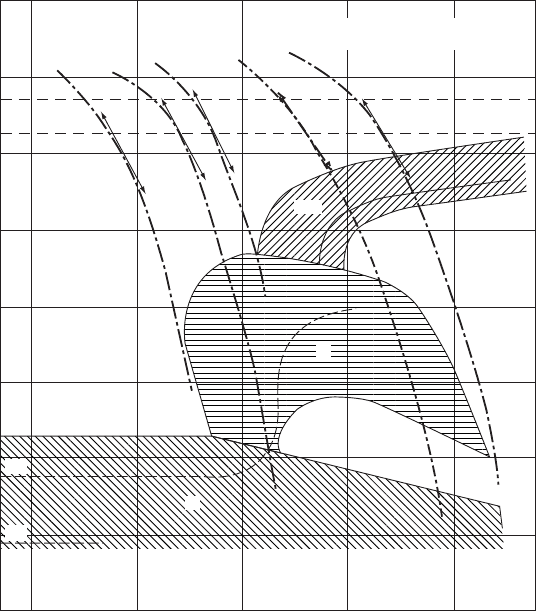
SYNTHESIS AND PROCESSING OF MATERIALS 377
The actual microstructure present in a quenched steel will often exhibit spatial
variations from the surface into the bulk, due to the fact that the cooling rate and
temperature will be different at different depths within the sample. This is certainly
the case in rapidly solidified steels, as discussed later.
Rapidly quenched steels that have both enhanced hardness and brittleness due to
the formation of martensite from austenite are said to have good hardenability.The
strength of the steel due to the martensite is enhanced as the C content is increased and
can result from a variety of strengthening mechanisms, several of which are described
later. When a martensitic steel is reheated so that the C can diffuse, the martensite will
be transformed into other phases, such as pearlite and bainite. This process, known as
tempering, is also described.
The cooling rates needed to transform a given steel completely to martensite can be
determined from another type of temperature–time diagram, the continuous-cooling
transformation (CCT) diagram shown in Fig. W21.20. This diagram provides infor-
mation concerning the kinetics of the transformation which is not obtainable from the
100
1 10 100 10
3
10
4
10
5
200
300
400
500
600
700
800
900
212
390
570
750
930
1110
1290
1470
1650
Time, s
Temperature, °C
Temperature, °F
V
1
(50)
V
2
(50)
V
1
V
2
V
3
Ac
3
Ac
1
M
B
F+P
M
50
M
90
M
s
Austenitized at 850 °C for 1/2 h
ASTM 12 grain size
Figure W21.20. The cooling rates needed to transform a given steel completely to martensite (M)
can be determined from the continuous-cooling or CCT diagram, shown here for 30 NC11 steel.
The ferrite (F), pearlite (P), and bainite (B) phase regions are also shown. (From ASM Handbook,
9th ed., Vol. 4, Heat Treatment, ASM International, Materials Park, Ohio, 1991, p. 26.)
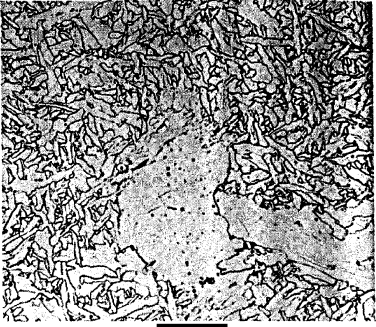
378 SYNTHESIS AND PROCESSING OF MATERIALS
Figure W21.21. Coarse acicular ferrite, a disorganized structure of randomly oriented ferritic
plates, is shown in a weld zone along with polygonal ferrite. The horizontal bar corresponds
to 20
µm. (From ASM Handbook, 9th ed., Vol. 9, Metallography and Microstructures,ASM
International, Materials Park, Ohio, 1985, p. 585.)
isothermal TTT diagram shown in Fig. 21.12. In the CCT diagram the ferrite, pearlite,
and bainite phases are shown in addition to martensite.
Acicular Ferrite. Acicular ferrite is a nonequilibrium phase that has superior
mechanical properties, including toughness, and consists of a disorganized structure
of randomly oriented, interlocking ferritic plates in a matrix such as martensite. This
phase can be obtained via the incorporation of small, nonmetallic inclusions that serve
as nucleation sites for the plates. It can also appear in weld zones (Fig. W21.21). The
morphology of this phase is three-dimensional since the ferritic plates can nucleate and
grow in several different directions around an inclusion. Whether bainite or acicular
ferrite is formed in a given steel as austenite is cooled depends on the ratio of nucleation
sites at austenitic grain boundaries to those at the surfaces of inclusions, with grain-
boundary nucleation leading preferentially to bainite. Ti
2
O
3
and other oxide particles
have been found to be especially effective in nucleating acicular ferrite, with the exact
mechanism remaining unknown.
Processing Treatments for the Strengthening of Steels. A variety of processing
treatments are used to strengthen steels and also other metals and alloys (e.g., Al alloys
and Ni alloys). Important examples of these processes are given now, and a brief
description of the strengthening mechanism is presented for each case. The strength of
a given steel often results from contributions from more than one of these mechanisms.
In practically every case the strengthening occurs via the pinning of dislocations, as
discussed in Chapter 10. The specific application for which a given steel is designed
will determine the conditions under which strength is needed (e.g., at high tempera-
tures, under repeated loading, along with good ductility, etc.). Due to the large number
of available processing variables, it is not possible to discuss here all of the important
processing treatments that can be used to strengthen steels.
Mechanical Work Hardening. The tensile strength of a plain carbon steel that contains
no other alloying elements can be increased up to 1500 MPa when it is drawn down
SYNTHESIS AND PROCESSING OF MATERIALS 379
(e.g., to a wire) in a work-hardening or cold-working process in which its cross-
sectional area is reduced by up to 95%. This large increase in strength produced by
plastic deformation results from the generation of defects such as dislocations and
dislocation arrays which reduce the mobility of other dislocations. The measured shear
stress typically arises from two dislocation-pinning mechanisms, one arising from
“small” defects, such as isolated dislocations, and the other from “larger” defects,
such as dislocation arrays. The former mechanism decreases with increasing T, due to
the thermally activated motion of dislocations around small defects while the latter is
temperature independent. Work hardening is discussed in more detail in Section 10.13,
where the dependence of the shear yield stress =
y
on dislocation density and strain is
discussed in detail.
Solid-Solution Strengthening. Steels can also be strengthened or hardened by the
presence of interstitial or substitutional impurities. The strong, attractive interactions
between dislocations and the interstitial impurities C and N play an important role in
this strengthening mechanism. Since interstitial C and N atoms as well as dislocations
produce their own strain fields in the material, the attractive interaction arises from an
overall reduction in strain energy when the C and N atoms reside in the strain field of a
dislocation. The binding energy of a C atom to a dislocation in Fe is ³ 0.5 eV. At high
interstitial concentrations the resulting distribution of interstitial atoms surrounding the
dislocation, known as the Cottrell atmosphere, can condense at the dislocation core.
The movement of dislocations under the influence of an external stress will clearly be
impeded by this interaction since the Cottrell atmosphere of interstitials has the effect
of increasing the effective mass or inertia of the dislocation.
The condensation of interstitial atoms near dislocations can occur in steels at temper-
atures even as low as room temperature, due to the high diffusivity of C and N through
defect-free regions of the material. Under applied stress and at higher temperatures,
thermal activation of dislocations away from the atmosphere of interstitials can lead
to a reduction of the yield strength. The strengthening process known as strain aging
occurs under an applied stress after the yield point has been reached when interstitial
atoms condense on newly generated dislocations.
The martensite structure, formed by rapid quenching, is usually very hard, due
primarily to interstitial C and the resulting solid-solution strengthening but also due to
the high densities of dislocations caused by the transformation of austenite to marten-
site. Martensite can, however, be brittle and not very ductile. The process known as
tempering, (discussed later), is often used to increase its ductility and toughness.
The strengthening resulting from solid solutions of substitutional impurities such as
Si, Mn, Cr, and Mo in steels results from the strain introduced into the structure by these
impurities and thus is greater for impurity atoms, whose sizes are quite different from
that of the host Fe atom. The increase of yield stress
y
of steel for various interstitial
and substitutional impurities is illustrated in Fig. W21.22. The interstitial impurities C
and N can be seen to have a much larger effect on
y
than the substitutional impurities
Si, Mn, Mo, and Ni due to the tetragonal distortions introduced into the lattice by C
and N. These tetragonal distortions allow the stress fields of C and N impurities to
interact with both edge and screw dislocations, while substitutional impurities have
spherically symmetric stress fields and so can interact only with edge dislocations.
Since substitutional alloying elements are usually added to the steel for other reasons
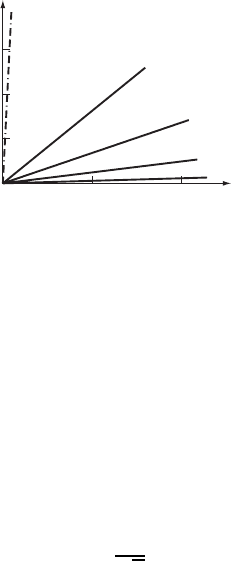
380 SYNTHESIS AND PROCESSING OF MATERIALS
100
150
50
0
0 1.0 2.0
∆ σ
y
[MPa]
% Alloy element
C, N
Si
Mn
Mo
Ni
Figure W21.22. Increase
y
of the yield stress of steel for various interstitial and substi-
tutional impurities. (From ASM Handbook, Vol. 1, Properties and Selection: Iron, Steels, and
High-Performance Alloys, ASM International, Materials Park, Ohio, 1990, p. 400.)
(e.g., to improve corrosion resistance or to combine with oxygen or sulfur), the increase
in strength associated with their presence can be considered a bonus.
Strengthening via Grain-Size Reduction. The reduction of grain size and the resulting
increase in the number of grain boundaries are some of the most effective ways of
increasing the strengths of steels. The Hall–Petch relation between the yield stress
y
and the average grain size d of a material,
y
d D
0
C
k
y
p
d
,W21.24
is described in Section 10.14. Here
0
, the yield stress for a single crystal with no
grain boundaries, and k
y
are constants that are independent of d for a given steel. The
strengthening effect of grain boundaries results from their ability to pin dislocations.
Reduction of the grain size in steels into the range 2 to 10
µm can produce yield
stresses of over 500 MPa. This reduction is typically achieved via hot rolling and the
addition of small amounts of certain alloying elements. The grain size can also be
controlled by varying the cooling rate (i.e., the time available for the grains to grow).
The kinetics of grain growth in metals are discussed in Section 21.5.
The growth of larger grains can be inhibited by the addition of small amounts,
< 0.1 wt %, of grain-refining elements such as V, Al, Nb, and Ti, which form carbides,
nitrides (e.g., VC and AlN), or carbonitrides. The 3 to 10-nm carbide and nitride
particles that are formed tend to pin grain boundaries, thus helping to prevent grain
growth. The resulting steels, which also contain 0.008 to 0.03 wt % C and up to
1.5 wt % Mn, have yield strengths in the range 450 to 550 MPa and are known as
high-strength low-alloy (HSLA) steels or micro-alloyed steels.
Dispersion Strengthening. The strengthening of steels through the introduction of
more than one structural phase in the ferrite matrix is known as dispersion strength-
ening. The typical phases present in plain carbon steels include carbides such as
cementite, nonequilibrium phases such as pearlite, bainite, and martensite, and the
precipitates formed by tempering. In alloy steels the thermodynamically more stable
carbides of Si, Mn, and V often replace iron carbides. Other possible phases in steels
include nitrides, other intermetallic compounds, and graphite.

SYNTHESIS AND PROCESSING OF MATERIALS 381
A simple relation has been developed by Orowan for the yield stress
y
of an alloy
containing a random distribution of spherical particles of a different phase which are
impenetrable by dislocations. With an average interparticle spacing , the result is
y
D
0
C
2T
L
b
,W21.25
where
0
is the yield stress of the particle-free matrix and T
L
and b are the line tension
(i.e., energy per unit length) and Burgers vector of a typical dislocation, respectively.
An order-of-magnitude estimate for the line tension is T
L
³ Gb
2
³ 1.7 ð10
9
J/m ³
10 eV/nm, using G ³ 82 GPa as the shear modulus and b D a/2 D 0.144 nm for Fe.
The term 2T
L
/b is the stress required to move a dislocation past a second-phase
particle via bowing. This process leaves a dislocation loop around each such particle.
Equation (W21.25) is only approximately valid for steels in which the precipitates are
plates or rods. In pearlite where the microstructure consists of a lamellar mixture of
cementite and ferrite, the parameter controlling the strength is usually the average size
of the uninterrupted ferritic regions, known as the mean free ferrite path (MFFP). In
this case the flow stress is proportional to (MFFP)
1/2
, a relationship of the Hall–Petch
type [see Eq. (W21.24)]. Thus the fine pearlite formed at lower T will be stronger than
the coarse pearlite formed at higher T.
The extent of the dispersion strengthening in a given steel is controlled by the C
content, by alloying, and by the processes that determine which phases are present
(e.g., heat treatment, tempering, etc.). When steels are quenched in order to form
martensite, they are typically very strong but also tend to be quite brittle. Subsequent
reheating or tempering of martensitic steels at an intermediate temperature between
T ³ 150 and 700
°
C (i.e., below the eutectoid temperature T
e
)isusedtoimprove
their ductility and toughness without at the same time causing too large a decrease in
strength. The tempering process is controlled by the diffusion of carbon, which comes
out of the supersaturated solid solution found in martensite and forms finely divided
carbide phases. The martensite is thus converted to ferrite and the resulting material
is then a dispersion of fine particles of cementite or transition metal (TM) carbides in
a ferrite matrix. The formation of TM carbides such as MoC, Mo
2
C, WC, W
2
C, and
VC
x
x ³ 0.75 occurs via precipitation and at much higher temperatures, T ³ 500 to
600
°
C, than that of cementite due to the much lower diffusivities in ferrite of these
substitutional impurities as compared to that of C. This process, which can involve the
conversion of cementite to TM carbides, is known as secondary hardening and is a
type of age hardening.
Alloying elements such as Ni, Mn, and Si are often added to steels to make them
heat treatable (i.e., to facilitate the heat treatment of austenite to produce martensite).
This occurs because the formation of pearlite is retarded and so the desired martensite
is more easily formed.
When the steel includes a high TM content (e.g., 18 to 25 wt % Ni along with Mo
and Ti), particles of intermetallic compounds such as Ni
3
Mo and Ni
3
Ti can be formed
via precipitation. Such materials are known as maraging steels and can have very high
yield stresses,
y
³ 2000 MPa, along with good ductility and toughness.
The nucleation and growth of particles, often of a second phase, in a matrix is
a recurrent theme in steels, especially in the discussion of dispersion-strengthening.
This topic is also discussed in Section 21.5, where the Johnson–Mehl equation for the
annealing and recrystallization (i.e., grain growth) of metals is discussed.
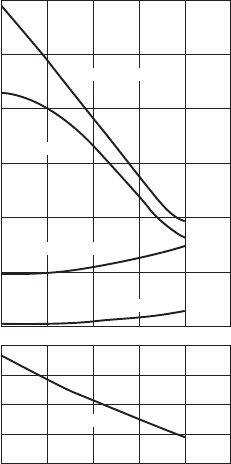
382 SYNTHESIS AND PROCESSING OF MATERIALS
In addition to their uses in the strengthening processes just described, heat treat-
ments of steels are used for a variety of other purposes. Various heat treatments are
given to plain carbon steels containing pearlite in order to achieve the desired pearlite
microstructures. As an example, spheroidizing annealing at just below T
e
is used to
transform the lamellar pearlite structure into one in which the pearlite takes on a
spheroidal microstructure (i.e., the cementite lamellae have been spheroidized). This
process leads to improved ductility and machinability of the steel. The driving force
for this process is the reduction of the surface energy between the cementite and ferrite
phases. This process is similar to the tempering of martensite discussed earlier, which,
however, results in much smaller cementite particles, due to the lower temperatures
used for tempering.
As just described, tempering is the term often used for the heat treatment or
annealing of steels to achieve desired changes in microstructure and mechanical prop-
erties such as improved ductility. For example, the strength of martensite falls quickly
and its ductility improves during tempering, due to the precipitation of C in carbides
or carbon-containing intermetallic compounds. In contrast, tempering has little effect
on bainite because there is not much C in solid solution. The effects of tempering on
the mechanical properties of a steel are illustrated in Fig. W21.23. Similar behavior is
observed for the tempering or annealing of nonferrous metals and alloys.
1500
1250
1000
750
500
1750
2000
205 315 425 540 650 760
Tempering temperature, °C
400 600 800 1000 1200 1400
Tempering temperature, °F
200
300
400
500
600
Hardness, HB
Hardness
Strength, MPa
Reduction of area
Tensile strength
Elongation
Yield point
Figure W21.23. Effects of tempering at various temperatures on the mechanical properties
(Brinell hardness, tensile and yield strengths, reduction of area, and elongation) for a 4340 steel
bar. (From ASM Handbook, 9th ed., Vol. 4, Heat Treating, ASM International, Materials Park,
Ohio, 1991, p. 123.)
